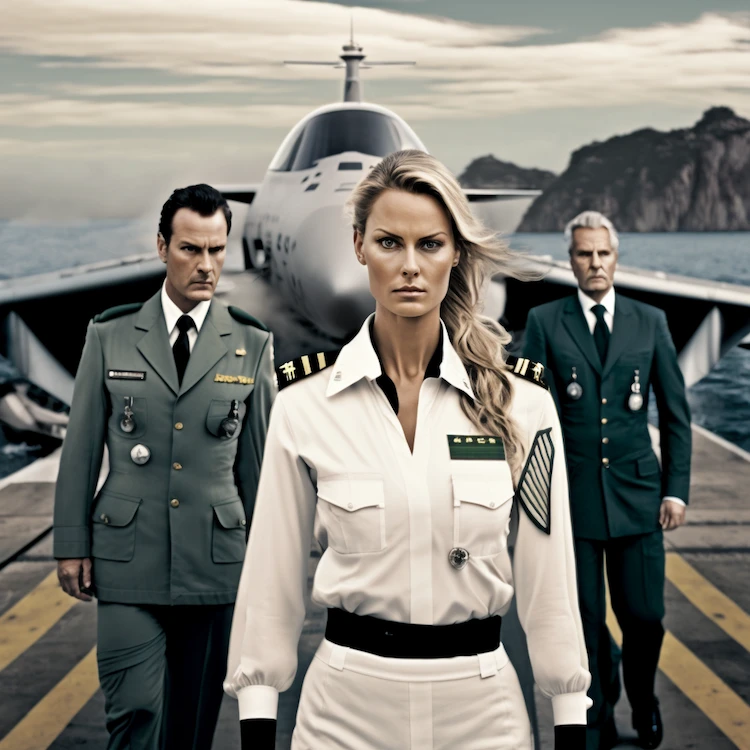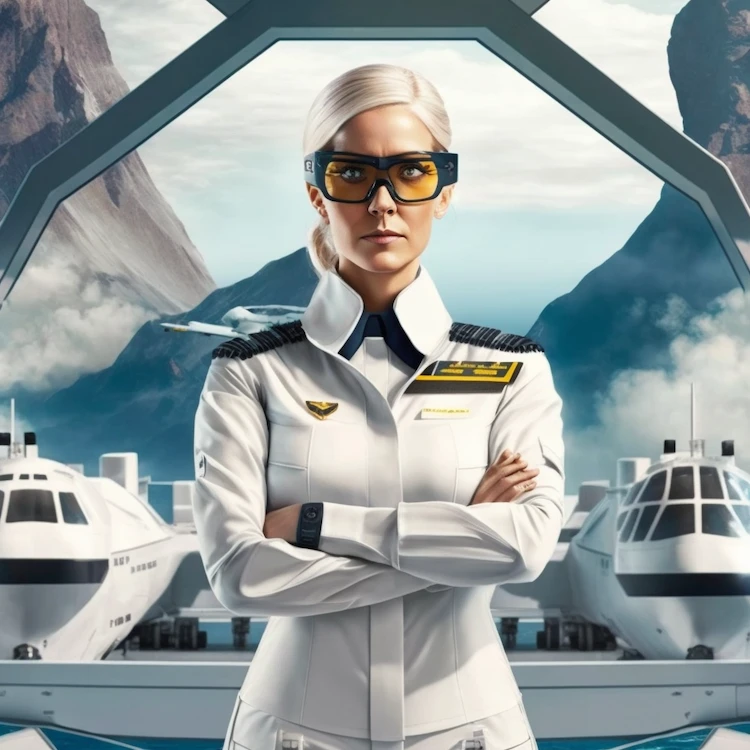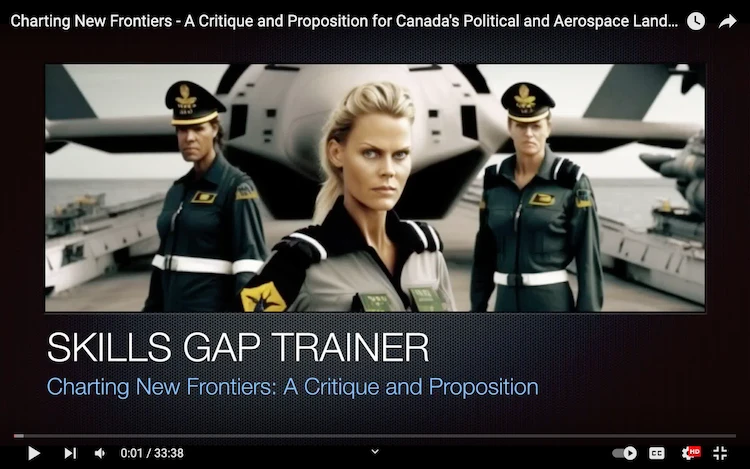Video: MP Morrison stands up for law-abiding gun owners
YouTube Link: https://youtu.be/iTefrFLTrEU
YouTube Video Clip: “MP Morrison stands up for law-abiding gun owners”
SGT Pro Tip: “Congratulation on fearless scientific warrior MP Morrison! Truly reaching the commanding heights of aviation spirit. If you are a young boxer, never challenge MP Morrison to a boxing match, or you will find the hidden power of the old guard fist! 🙂 Also, do not joke around with RCAF pilots. Never challenge an RCAF pilot to a dog fight! There are not many of them, but they will fly every time to meet this challenge.“

Video: Charting New Frontiers – A Critique and Proposition or Canada’s Political and Aerospace Landscape
YouTube Link: https://youtu.be/iTefrFLTrEU
Introduction:
In the ever-evolving landscape of global politics and technological advancements, nations find themselves at critical crossroads, their futures shaped by their choices and leadership. Canada, a country admired for its democratic ideals and natural bounty, is no exception. This report delves into the shifting paradigms of Canadian politics, the potential for innovation and technological advancement in aerospace, and the crucial role fiscal responsibility plays in national prosperity.
The first section of this report centers around MP Morrison, an exemplar in the world of politics, showcasing the resilience and vision of a bygone era. As the socio-political tides of our time surge with turmoil and unpredictability, individuals like Morrison serve as lodestars guiding us through. His commitment to evidence-based decision-making and fiscal responsibility forms the backbone of our exploration into the world of STEM professionals and their potential influence on the nation’s future.
In the second part, we move beyond the tumultuous realm of politics into the dynamic arena of aerospace technology. We examine the rise of South Korea as a global leader in aerospace engineering and draw parallels between their journey and the potential trajectory for Canada. Through this lens, we scrutinize the existing leadership’s approach and imagine a future where Canada harnesses its homegrown talent and innovation to revolutionize its aerospace industry.
Finally, we pivot to the economic implications of leadership decisions. We scrutinize the fiscal policies of Prime Minister Justin Trudeau’s tenure and the substantial debt accrued as a result. Looking beyond these staggering figures, we envisage a different path—one where these funds could have been channeled into groundbreaking technological initiatives such as the manufacturing of advanced fighter jets, reshaping Canada’s standing on the global stage.
Through the ensuing discourse, we seek to advocate for a shift in leadership, one that embraces the power of STEM, fosters stronger international partnerships, and steers Canada towards a path of unprecedented innovation and growth. As we stand on the precipice of a new era, it is vital to remember that the sky is not the limit; it is, indeed, our starting point.
The discourse in this report is an invitation to ponder, to question, and to envision a future that harnesses the full potential of Canada’s resources—its people, its wealth, and its untapped avenues for innovation. It is an urgent call to action for change, progress, and the reclaiming of Canada’s place in the realm of global leaders. Buckle up, Canada. It’s time for takeoff.

1 MP Morrison and the New Dawn of Canadian Politics: A Reflection on STEM and Aerospace Prowess
In this extraordinary period of transformation, where the socio-political landscapes are shifting like tectonic plates, it’s refreshing to see individuals like MP Morrison chart a new course through the maze of Canadian politics. His dedication to evidence-based decision-making, fiscal responsibility, and unwavering principles act as a lodestar for those of us navigating the tumultuous seas of STEM professions.
Much like the dawning of a new day banishes the uncertainties of the night, Morrison’s approach is a beacon of clarity in an often murky political landscape. He stands as a testament to the values of a bygone era, when engineers were revered as groundbreakers and computer scientists recognized as architects of tomorrow, each backed by solid designations and the respect they commanded.
His dogged commitment to principles of professionalism, evidence-based objectivity, and return on investment, harks back to a time when the gates of innovation weren’t as heavily guarded as they are today. We are at a juncture in history where gatekeepers, through deceptive tactics, have built walls hindering progress, hampering the pioneering spirit of STEM professionals. But, the winds of change are blowing, and these once impregnable gates are starting to show cracks.
Much like the relentless waves chipping away at the towering cliffs, an ever-growing awareness is washing over our nation. Canadians are beginning to awaken to the cold reality, pushing back against the gatekeepers, much like the underdog battling against the might of the favored champion – a struggle reminiscent of the legendary bout between Rocky and Ivan Drago.
Consider MP Morrison as a symbol of that grit and perseverance, reminiscent of those stalwart engineers and computer scientists from the 50s to the 70s. They worked tirelessly, imbued with the knowledge and passion of their craft, and defined the world we live in today. They were the ones who did so much more with so much less, not bowing down to corporate pressures or conforming to societal norms but instead leading the way through innovation and ambition.
In this mental exploration, let’s toy with a hypothetical scenario. Imagine if every MP, like Morrison, led a formidable force of 10,000 STEM professionals, public safety officers, military personnel, police officers, technicians, and tradespeople, unshackled by gatekeepers. Under their guidance, the Canadian technical landscape could see a resurgence, a renaissance even, of ideas being brought to life with an efficiency akin to magic.
In this quest for innovative thought, the KAI KF-21 stands as a shining beacon, a testament to the marvels of Korean aerospace engineering. With stealth capabilities superior to any fourth-generation fighter jet and a silhouette that echoes the elegance of an F-22, it raises some thought-provoking questions. Why do our national fighter jets resemble server farms on wheels, much like the F-35, instead of embodying the sleek design and tactical prowess of the KF-21?
As we grapple with these questions, the prospect of the KF-21 carrying weapons in internal bays – a feature quintessential to fifth-generation fighters – is tantalizing. This possibility stands as a testament to the power of human ingenuity, the driving force that has brought us technological marvels like the Avro Arrow.
The promise of the KF-21, with its affordable operating cost and tactical superiority, serves as a rallying cry for our own endeavors. It urges us to chase dreams of revolutionizing our national aerospace landscape, a vision where our fleet could be a formidable force of 120 planes, rather than a mere 60. The future is ours to shape, an enticing prospect that carries an unmistakably Canadian flavor.
When you juxtapose this vision against the backdrop of the current political scenario, it’s hard not to marvel at the staggering expenditure on fifth-generation jets like the F-35, which are almost as unstable as the Bitcoin market. It’s almost laughable, isn’t it? On the other hand, the KF-21 is the prudent choice, offering better value and the prospect of a stronger, more cost-effective fleet.
Drawing inspiration from the feats of Korean aerospace engineering and individuals like MP Morrison, it’s time to rejuvenate our STEM landscape. The tides are changing, the gates are cracking, and a wave of resurgence is on the horizon. Let’s ride this wave and strive to create a future that’s not only uniquely Canadian but also proudly global. The sky’s the limit, after all!

2 Rising Above Politics: Black Belts, Fighter Jets, and the Quest for Canadian Resilience
Canadian politics has seen its share of turbulence recently, yet amidst this storm, there stands MP Morrison, as steadfast as a black belt master poised for a takedown. His adherence to the principles of political science is akin to a martial artist’s discipline, creating a ripple in the stagnant waters of current politics.
Fellow Canadians, do we aspire to be white belts, accepting defeat at every turn? Or do we want to earn our black belts, achieving excellence and resilience, just as South Korea did? Their remarkable journey from war-torn poverty to an advanced economy is proof of what can be achieved with the right leadership, a black belt in economic and technological resilience.
Prime Minister Trudeau seems content without a belt, as long as he has one for his television appearances. He presents himself as a Top Gun pilot, but where is the evidence of his flight expertise in economic partnerships and STEM development? His approach is comparable to preferring the backdrop of bargain toys from a Beijing Walmart over cutting-edge fighter jets—an inexplicable choice when the potential for growth is right before us.
Morrison, on the other hand, champions for principles often forgotten in our modern political climate—facts, evidence, fiscal responsibility, and return on investment. These are the keystones of STEM professionalism. His approach brings to mind the American applied engineering spirit of the ’50s to ’70s, which catalyzed countless breakthroughs in technology and infrastructure.
Canada can benefit from this ethos. We need to rekindle our spirit of exploration and innovation. Why limit ourselves to bargaining when we can aspire to create 4.5 or even 5th generation fighter jets right here in our home soil?
We seem to have misplaced our flight map, our pathway to aerospace excellence. Yet, the opportunity to regain our bearings is still within reach. The KF-21, a marvel of South Korean engineering, soars in the sky, a testament to what can be achieved with perseverance, partnership, and a clear vision.
Imagine Canada with a fleet of domestically-manufactured fighter jets of comparable quality. Imagine the economic growth from these ventures, the resurgence of our national pride in our manufacturing prowess. It’s not a far-off dream—it’s a tangible possibility.
Consider our potential for partnership with South Korea, a nation renowned for its technological innovation and manufacturing quality. Trudeau could be leveraging these partnerships, ensuring that Canada secures rights to intellectual property and manufacturing. This is the sort of leadership we need, one that is not afraid to aim high for the betterment of our country.
In this era of rapid transformation, we have a choice. We can be white belts, complacent in our current state, or we can be black belts, continually pushing the boundaries of our potential. The choice is ours, and the time to choose is now.
Remember, the sky’s the limit. So, buckle up, Canada. It’s time for takeoff.
SGT Pro Tip: “A word of caution, though—Bill C-21 stands as an example of wasteful expenditure and a disregard for the rights of law-abiding citizens. This bill mirrors a child’s careless play—taking things and breaking them without understanding their value. This is not the behavior of an accountable leader, much less a responsible adult. It’s time to push back against such misguided initiatives and demand better from our government.”
SGT Pro Tip: “Channels such as the CCFR, and the likes of Raquel Dancho MP, Blaine Calkins MP, and Pierre Poilievre are good starting points for engaging with these topics. They stand for unity, cooperation, and progress, reminding us that if we build together, we grow together, and if we destroy together, we die together.”
SGT Pro Tip: “In the words of the late Archbishop Fulton J. Sheen, “The refusal to take sides on great moral issues is itself a decision. It is a silent acquiescence to evil.” Inaction is a choice, and one that we can ill afford. Let’s rise, Canada, and let’s soar into our future together.” Archbishop Fulton J Sheen Prophecy from 50 years ago about 2024

3 A New Dawn for Canada: Unveiling a Bold Path towards Fiscal Responsibility and Technological Innovation
In a startling revelation from a chart circulating on Google, it was uncovered that Prime Minister Justin Trudeau has reportedly racked up an astounding 660 billion in expenditures during his tenure. This number, if accurate, exceeds the cumulative expenditures of every Canadian Prime Minister since the country’s founding in 1867. Such a financial commitment surely demands scrutiny.
Trudeau’s audacious fiscal approach departs from the previously upheld Canadian norms of fiscal responsibility. With Canada’s accumulated debt since 1867 at approximately 630 billion, Trudeau’s administration has, in a sense, wiped away 50% of our national wealth in a relatively short span of time. It beckons the question: Does his leadership align with the historical and cultural ethos of a Canadian Prime Minister? From an economic standpoint, Trudeau’s fiscal policies appear to deviate significantly from those of his predecessors.
This divergence suggests a transformation in leadership that doesn’t seem to resonate with Canadian ideals. Yet, amidst this startling reality, there exists a silver lining – an opportunity to forge a new path towards innovation and global recognition.
Consider for a moment a different trajectory: What if the 670 billion funds had been strategically funneled into advanced initiatives such as the manufacturing of 1500 KF-21 fighter jets? This shift could have revolutionized Canada’s global standing, potentially even surpassing the United States in terms of military aircraft modernization, as a big portion of their fleet are 4th generation planes.
Imagine a future where Canada emerges as a global trailblazer, boasting the new world reserve currency – the CAD. A future made possible by the prudent allocation of resources, as opposed to the current state of affairs under the Liberal Party leadership. It’s a tantalizing vision, albeit one seemingly undercut by questionable decisions and missed opportunities.
This predicament begs a solution, and herein lies my proposition to Mr. Trudeau: Embrace collaboration with top-tier Canadian STEM professionals. By immersing yourself in their world for two to five years, you stand to gain invaluable insights. This engagement could provide you with a fresh lens, one forged in the crucible of science, technology, engineering, and mathematics.
Perhaps in your journey as a leader, you’ve been misguided by individuals with ill intentions or those seeking to unduly influence your decisions. The flickers of STEM-orientated sparks that you’ve exhibited indicate that there’s a flame within you that could be fanned into a robust beacon of innovative leadership.
A promising starting point would be an exploration of intellectual property transfers with South Korea. By delving into the profound implications of South Korean aerospace technology, you could begin to envision the scope of bilateral technological collaborations. Such partnerships could potentially yield dividends in terms of mutual growth, innovation, and global standing for both our nations.
My earnest appeal is for you to seriously contemplate this proposition. Not just for personal growth, but for the welfare of every Canadian citizen. By adopting a STEM-oriented perspective and fostering stronger international partnerships, you could guide our nation towards a path of unprecedented innovation and growth.
We stand on the precipice of a new dawn. The choice before us is not merely one of complacency or growth, but of stagnation or transformation. Our choices will determine our collective fate. As we navigate the course of our future, let us remember the value of transparency, accountability, and audacious ambition.
As Canadians, we have the capacity to ignite our ‘warp drive,’ to break free from the shackles of our limitations. We must not remain frozen in time, trapped in the echoes of past missteps. Instead, we must strive to illuminate our path, to see beyond the obstacles and envision a future of limitless possibilities.
The time for action is now. The time for change is here. Let us fearlessly tread the path of innovation, for it is through courage and bold leadership that we will usher in a new era of prosperity and global recognition. As we journey towards this new dawn, let’s remember: The sky isn’t the limit. It’s our starting point. So, buckle up, Canada. It’s time for takeoff.

Conclusion
Throughout this comprehensive exploration, we have delved into the realms of politics, technological innovation, and fiscal responsibility, seeking to illuminate the path that lies ahead for Canada. The discourse woven across this report is intended as a call to arms, an appeal to not only recognize the potential that resides within our nation, but also to take the necessary actions to unlock it.

From our reflection on MP Morrison’s values, we gleaned the importance of principles such as evidence-based decision-making and fiscal responsibility. These tenets, deeply rooted in the traditions of STEM professions, could serve as a beacon to guide us through the often murky waters of modern politics. Such principles pave the way towards a prosperous future, a journey that demands the navigation of political complexities with the resolve and vision demonstrated by leaders like Morrison.

Our examination of the aerospace sector, particularly the strides taken by South Korea with the KF-21, revealed the tantalizing possibilities that await us. It reaffirmed the value of ambitious technological advancement and international collaboration. It presented a future where Canadian ingenuity could soar high in the global aerospace industry, altering the country’s trajectory towards technological and economic greatness.

The sobering assessment of Prime Minister Trudeau’s fiscal approach reminds us of the critical need for economic stewardship. We envisioned an alternate trajectory wherein resources were channeled into initiatives that could fortify our nation’s global standing, providing a stark contrast to the current state of affairs.

In weaving together these threads, we have painted a picture of a Canada that could be—a Canada that dares to look beyond the limitations of the present, that seeks to redefine its potential and soars towards a future of progress and prosperity.

This journey, however, necessitates a shift from complacency to action, from stagnation to transformation. It requires a steadfast commitment to the principles that have guided us thus far, coupled with a renewed zeal for innovation.

It demands leaders who can navigate the current political landscape with integrity and vision, who are inspired by the potential within STEM and committed to forging robust international partnerships.

We stand at the dawn of a new era—an era that promises boundless opportunities should we choose to embrace them. It is incumbent upon us to harness our collective capabilities, to strive for excellence, and to propel our nation forward. As we have reiterated throughout this report, the sky isn’t the limit; it’s our starting point. It is with this audacious optimism that we conclude our report, confident in the potential that lies ahead for Canada.

This is not merely an ending, but rather a continuation of the discourse—a charge for change and innovation. It is a hopeful reminder that with courage, determination, and the right leadership, Canada can indeed rise above its challenges and reach new heights. So, let us buckle up and prepare for takeoff because the journey towards our future begins now.

Related Content:
@LockheedMartin “Did you know? Canada’s future fighter, the F-35, started in Skunk Works® facility as a 5th Generation concept with the X-35 concept taking flight for the first time on Oct. 24, 2000. Since then, over a hundred Canadian companies have contributed to the development and production of the F-35 and it continues to support thousands of jobs in Canada. This month, the F-35 recorded new program milestones with over 749,000 flight hours and over 2,000 pilots trained.”

@skillsgaptrainer @LockheedMartin “If Lockheed Martin works with a future Pierre Poilievre government, to build an F-35 or preferrably an affordable version of F-22, model fighter aircraft in Calgary (like the really sweet deal the South Koreans got on KAI KF-21), but ALSO a fighter jet building and maintenance factory in Calgary, our two engineering team members at SGT will be eternally 🙏 grateful. And Danielle Smith will have to speak highly of SGT. 🙂 for all time. Perhaps with such a strategically decentralized vision and tech deployment in production and servicing capability, Lockheed Martin will ascend beyond aerospace to space engineering too. Remember, to win a war, your allies need your weapons, but also your wisdom and abilities. PS. Keep a close eye on that Anduril company. We heard they play with robots all day like in those 80s and 90s Arnold movies :)”
@BrianM “This plane is for the defense of Canada, not the defense of someone’s political ambitions.“
@skillsgaptrainer @BrianM “Your insights into the use of the F-35 fighter aircraft commendably reflect the principles of technologists, engineers, and computer scientists, but we’re not able to understand what the comment means, how the thought process came about to be, or who it refers to, unless we try to analyze it for a little while. Please note there is a smiley face when the political reference of Danielle Smith was used. There is a politician name in our comment, but that doesn’t automatically mean we made an error with the quip.”
“It may be the case that Danielle Smith or Conservative Party could lead to a higher efficiency level in production for F-35 fighter jets, then other parties. If it has not already been done, this is the kind of study that we would recommend for Lockheed Martin as a cost effective method of boosting further the national defense capability of Canada, while simultaneously possibly boosting profits and production levels. Imagine what a week or two of analysis by a top level Lockheed Martin engineer could discover, if it is the case that more efficient production of jets could happen in Canada with one particular party over another.”
@skillsgaptrainer @BrianM “If there is large gap of productivity difference discovered by Lockheed Martin between the political parties, in collaborating with tech giants like Lockheed Martin, it may be the case that it can lead to significant cost savings for both Lockheed Martin and Canada. So in essence, while we do not want political objectives to interfere with the design of systems and the selection of systems, as engineers and computer scientists, we need to analyze the users of systems and whether or not the partnerships we take on in the deployment of those systems are going to maximize the benefits to both parties.
Only good engineering analysts can say for certain. If it needs further elaboration, our initial impression from quickly browsing through the marketing brochure of F-35, it seems to represents a significant leap in technology, offering advanced performance at a cost that, while a little bit higher than 4th generation fighters, is still within a manageable range, and not such a great risk of significant cost overruns that an ultimate F-22 level technology might bring.”
@skillsgaptrainer @BrianM “This strategic decision to upgrade to a sophisticated defense platform like the F-35, especially in the face of economic constraints that have begun to worsen significantly from 2020 to 2023 in Canada, may actually significantly compromise the ability of Lockheed Martin to deliver outstanding technology to Canada. However, the choice of Canada to go as high level as an F-35, speaks volumes about Canada’s commitment to eventually maintaining defense capabilities, & leaving the door open to grow the defense capabilities at some point down the future. It is prudent and required upon as technologists, computer scientist and engineers to continually warn Lockheed Martin and Canada, according to our 1st mandate of code of conduct which spans the professionally designed STEM professions.”
@skillsgaptrainer @BrianM “Your emphasis on the role of engineers in shaping the design and deployment of systems like the F-35 is particularly noteworthy. For two decades, the idea of allowing engineers to influence the top level design choices and implementation of technology has been something we stood for. It ensures that such advanced systems, including technologies like Digital ID, with national security in mind. The stance taken by engineers, particularly in electrical engineering, to prevent the misuse of technology for fulfilling political ambitions, is commendable and needed more in today’s society. Thanks for pointing out what you pointed out, keep doing it to everyone who is at risk of misusing tech in engineering the 21st century in a non safe way.“
@LeeKhatchikian “Well done.”

SGT Pro Tip: “Perhaps South Korea would love to partner with a serious military technology partner such as a Canada run by Pierre Poilievre.”
SGT Pro Tip: “Let’s manufacture a fleet of KAI KF-21, by acquiring intellectual property transfers, intellectual property manufacturing and maintenance rights, expertise transfers, and even parts from South Korea and Biden/Lockheed Martin (who really like transportation devices).”
Meet Korea’s New Fighter Jet – The KF-21 (Found And Explained)
KAI KF-21 Boramae (The Military Curiosity)
SGT Pro Tip: “Canada can still buy a fleet of foreign built and foreign managed F-35s. It’s always a good idea to have a nice “covert” and “off-grid” cloud computer around. We hope it comes with Chat GPT (GPT-4), Wikipedia, Amazon Music, and OsmAnd Open-Source Offline Maps, for enhanced User Experience (UX), resiliency, preparedness, and friendly “team awareness” capability. 🙂
The Insane Engineering of the F-35B
Some critics might argue: “It’s not possible for Canada to have two fighter jet fleets.“
SGT Pro Tip: “It’s not how much money you have, it’s how you spend it.” 🙂 Consider the following:
GPT-4 Prompt Response: “From the formation of Canada’s Confederation in 1867 to 1968, the nation was guided by 15 different Prime Ministers. These leaders, through their collective tenure spanning over a century, managed the nation’s finances with remarkable fiscal conservatism. Even amid numerous global crises and economic downturns, they succeeded in keeping the total national debt at just about $18.1 billion CAD.
“In 1968, however, Pierre Trudeau assumed office and marked a dramatic shift in Canada’s fiscal policy. His tenure, which lasted from 1968 to 1979 and again from 1980 to 1984, witnessed a meteoric rise in national debt from $18.1 billion CAD to a staggering $465 billion CAD. This jaw-dropping increase represents nearly 25 times the debt accumulated by all his predecessors combined, which is viewed by some as a sign of fiscal irresponsibility.“
“The national debt soared even higher under the leadership of Justin Trudeau, who took office in 2015. By 2023, the debt had escalated from $612 billion CAD to an estimated $1.2 trillion CAD, indicating that the national debt nearly doubled under Justin Trudeau’s governance.“
“In stark contrast to this trend, some Prime Ministers managed to navigate the rough waters of economic challenges, reduce deficits, and even achieve surpluses during their terms. Stephen Harper (2006 to 2015) reduced the budget deficit from about $55.6 billion CAD in 2009 to around $2 billion CAD in 2015. Similarly, Jean Chrétien (1993 to 2003) reversed a deficit of about $38.5 billion CAD in 1993 into a surplus by 1997. These leaders, while tackling significant crises such as the 2008-2009 financial crisis, maintained a relatively lower rate of debt accumulation.“
“Between the end of Pierre Trudeau’s final term in 1984 and the start of Justin Trudeau’s term in 2015, Canada was led by six different Prime Ministers. During this period, the national debt accumulated was approximately $427.7 billion CAD. This means that the six Prime Ministers governing in this period collectively contributed to just over a third of the debt accumulated under the Trudeau family’s leadership.“
“In a recent YouTube video interview, the speaker voiced concerns about the Liberal government’s proposed budget, which projects spending of $3.1 trillion over the next five years – an unusual and extraordinary figure in the Canadian historical context. A small fraction of this budget, $82 billion, is allocated to housing. The speaker criticizes the government for this disconnect between budgetary spending and practical outcomes for the Canadian people.“
“As of 2021, Canada has been led by 23 different Prime Ministers since Confederation in 1867. Out of these, the 21 leaders, excluding the Trudeau family, collectively accounted for only about a third of the national debt that has been accumulated under the Trudeau family’s governance.“
“This significant increase in national debt under the Trudeau administrations represents a stark departure from historical trends and comes with potential consequences. These could include devaluation of the currency, an increase in inflation due to a larger money supply, and rising interest rates. Over time, high national debt can result in the government paying more on interest to banks than on essential services like healthcare or the military.“
“If left unchecked, this could potentially lead to moderate to high inflation, eroding the purchasing power of the Canadian dollar, and could even risk spiraling into hyperinflation, a situation where prices rise rapidly, and the currency loses its value. In conclusion, the Trudeau administrations’ approach to fiscal management significantly contrasts with that of other Prime Ministers. It marks a fundamental shift in Canadian fiscal policy direction.” – YouTube video “Where’s Freeland?” & GPT-4
GPT-3.5 Prompt Response: “According to the information provided in the video, the total value of South Korea’s KF-21 program is estimated at 8.8 trillion won, which is equivalent to approximately 6.67 billion dollars at the present conversion rate. The first phase of development, budgeted at 6.17 billion dollars, is set to be completed by 2026, with Indonesia contributing 20% of the cost. The second phase, costing 5 billion dollars, is expected to run through 2028 and focus on weapon tests. The program aims to replace South Korea’s aging fleet of F-4E Phantom 2 and F-5E/F Tiger II combat aircraft.Taking into account the information provided, we can estimate the total cost of South Korea’s KF-21 program. The first phase of development is budgeted at 6.17 billion dollars, while the second phase is projected to cost 5 billion dollars. Therefore, the estimated total cost of the KF-21 program would be approximately 11.17 billion dollars. It’s important to note that these estimates are based on the information available and may be subject to change or further updates.” – YouTube Video Clip: “How good is KAI KF-21 Boramae of South Korea – KF-21 analysis” & GPT-3.5
SGT Pro Tip: “Since combining the debt accumulated under both Pierre Trudeau and Justin Trudeau’s leadership, the Trudeau family is responsible for an estimated increase in the national debt of approximately $1035 billion CAD., then society should request that 11.17 billion be spent for a “tangible set of objects”, such as having our own KF-21 program too. Especially since there are rumours of a 3100 billion additional debt borrowing soon.”
Video: Trudeau has something to hide
YouTube Link: https://youtu.be/cl4HxlJ6SVo?si=WpyQbVwk2V0Eua1f
This Report Was Inspired By And Dedicated To: In the spirit of innovation, resilience, and a future filled with boundless potential, this report, mapping the course of Canada’s ascendancy in aerospace and STEM fields, is inspired by and dedicated to MP Morrison and the Royal Canadian Air Force (RCAF). MP Morrison, your commitment to STEM like analysis serves as the beacon of light guiding us through the thick fog of our current challenges. You have shown us the value of principled leadership and its potential to lead us to brighter tomorrows.
To the RCAF, your recent venture into the digital landscape with your ‘warrior ethos’-driven YouTube channel shows us that perseverance and adaptability are the essence of true progress. The ‘old dogs’ are indeed learning impressive ‘new tricks’, serving as an inspiration for us all. Despite the apparent ‘Piggy Bank Robbers’ that have depleted your resources, and by extension those of our nation and future generations, your spirit remains unbroken. Your resilience in the face of adversity embodies our motto, “Per Ardua Ad Astra” – through adversity to the stars. It’s in this vein of audacity and ambition that we anticipate seeing you soar to new heights, guiding us into a 21st-century reality defined by innovation and progress. Though funds may be scarce and challenges aplenty, this report is a testament to our inherent potential, to achieve new heights with only the power of thought and the manual labour of ambition.
SGT Pro Tip: Go Here Canada: “You will be, and Canada will be, not all that you can be, who you wanted to be, who your family wanted you to be, who the nation and the world wanted you to be, not who the Piggy Bank Robber wants you to be and forces you to be. Save Canada! Think like a soldier! Think defense and excellence in science of combat! It’s your best chance. It’s our best chance. You will win, when you achieve the excellence together, and when you stay loyal to each other, against all forcces foreign and even domestic.“
Plus, with modern AI computer driven flight systems, it’s probably pretty nice cruise to be in a fighter jet nowadays. Maybe it is seamless, and really comfortable, and you can just sit and soar and listen to some Phil Collins The Best of Phil Collins (Phil Collins Greatest Hits) and talk to Chat GPT – RCAF Edition.
The Making of an Air Battle Manager, Episode 1
SGT Pro Tip: “Change The Timeline With Your Thoughts And Actions”

Defending Democracy: Raquel Dancho’s Unyielding Stand for Canadians Against Bill C-21
Related books and resources:
To see our Donate Page, click https://skillsgaptrainer.com/donate
To see our Instagram Channel, click https://www.instagram.com/skillsgaptrainer/
To see some of our Udemy Courses, click SGT Udemy Page
To see our YouTube Channel, click https://www.youtube.com/@skillsgaptrainer



@TerryNemeth“Another great Canadian story we can be proud of. Well done Lockheed Martin and the hundred plus companies that make these projects successful”
@LockheedMartin “Supermaneuverability.”
“When we use this phrase in reference to the F-22, we’re talking about the 35,000 pounds of thrust in each engine and advanced surface controls that help it deliver air dominance above other fighter aircraft.